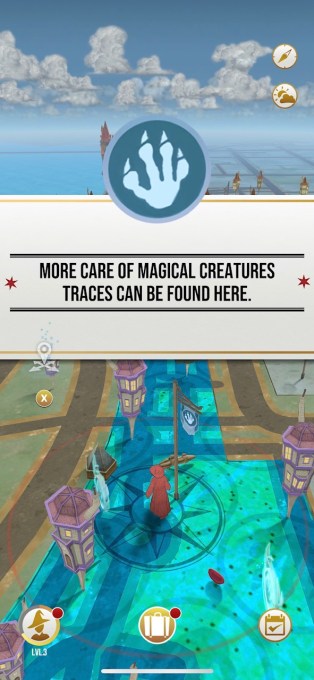Summer of 2016, Niantic and Nintendo released Pokemon Go, an augmented reality game that let players capture Pokemon in the world around them. It quickly took the world by storm, becoming a global phenomenon. Three years later, Niantic and Warner Bros. have partnered to create a similar experience with Harry Potter to see if lightning will strike twice. So far, Harry Potter: Wizards Unite hasn’t had the same wondrous start, but is it a better game? Well, yes and no. While it has a lot more to do than Pokemon Go did at launch, it lacks the level of polish that its predecessor has now. It’s worth noting that like many mobile games, Harry Potter: Wizards Unite is a work in progress. This review will focus on the current state of the game as released, but will get updated if significant changes occur.
Wizards Unite takes place nowadays, years after Harry Potter defeated Voldemort. However, an event known as the Calamity has occurred, displacing objects and characters throughout time into the present day, where they risk exposing the magical world. Thus players take on the role of a member of the Statute of Secrecy, tasked with sending these Foundables back to their time and place. Each Foundable has a Confoundable guarding it, such as a troll or werewolf. Players cast spells to free the Foundables, which places a record of this in their Registry, a sort of wizarding sticker-book. Players can also brew potions, take on dark wizards at fortresses, and choose a profession to aid them in their quest.

The premise is an intriguing one, and has a whole storyline built around it. The story may interest Potter fans, perhaps not others, but it is crafted in such a way that you can take it or leave it. Fully-voiced characters, such as new ministry official Constance Pickery and Harry Potter himself, speak to the player about what they think caused this event. While not voiced by the original actors, most of the voice actors for the returning characters do an excellent job replicating the voices of the originals. The story elements are also doled out fairly consistently throughout, so if you would like to follow it you won’t get lost.
As for the gameplay, Wizards Unite boasts a variety of things to do. Most of these elements consist of casting spells, unsurprisingly, but not all spells are created equal. When freeing Foundables, players trace the lines of various spells with their fingers as quickly and accurately as possible. In this instance it tends to get tiring, but gets more interesting when used to battle wizards and creatures. In wizarding duels, players take turns casting spells and blocking, a fast-paced mini game that adds a sense of urgency to these encounters. Spells may also be used to speed up potion making and collect food from inns.

But in a way, less is more. While Wizards Unite has many screens and menus telling you what to look for and what you’ve seen, a lot of it feels like unnecessary filler. The game also assumes that collecting pictures will prove as much of an incentive as needed to keep playing. While getting a sticker of Hagrid to admire is well and good, it’s nowhere near as rewarding as, say, getting a legendary Pokemon that you can train, battle, or trade with a friend. Collecting just isn’t an intrinsic part of the Harry Potter universe. Additionally frustrating is the fact that these pictures are needlessly difficult to obtain. Many of them require players to keep farming their Foundables for fragments that eventually form the photo itself. When freeing the Foundables, they’ll frequently resist your magic, and many times will simply disappear if you don’t have a high enough level. The worst aspect of all of this is the fact that you have a finite supply of spell energy. Each time you cast a spell it costs energy, which can only be obtained at inns. Since so much of the game involves casting spells, I frequently found myself running low. If you’re not near an inn, the game basically becomes unplayable.
The one aspect of the game that has the most promise is that of teaming up with other players to battle the dark forces inhabiting fortresses. Each profession, Auror, Magizoologist, and Professor, has its own strengths and weaknesses, and players will want to form teams that complement each other well. Once in the fortress battles, each player takes on an enemy one on one, but they can cast spells that benefit each other or the whole team. It’s here that the game really shines. You can battle fortresses at any time, and with others the game has a decent amount of strategy involved. However, even this feature is held back by a couple of others. While the professions offer many abilities and skills, several of these are locked behind fetching books through the Foundable tasks. The social aspect of the game could also use some fleshing out. Players can add their friends in the game right from the get go, but so far the bonuses are limited to these fortress battles. If you’re not friends with someone, it can be hard to coordinate fortress raids.
Ultimately, Wizards Unite has potential as a mobile AR game. The fortress element proves that it doesn’t need the collecting conceit of Pokemon Go to be an engaging game. However, it appears that Niantic has yet to realize this. Most of the gameplay is centered around collecting stickers, which just isn’t compelling. Limited spell energy hinders playing, especially for rural players without access to inns. Hopefully the social and role-playing elements get expanded, but until then Wizards Unite is short on magic.
Summary
Harry Potter: Wizards Unite has some neat augmented reality and role-playing elements, but it focuses too much on rote collecting mechanics to truly live up to its potential.


